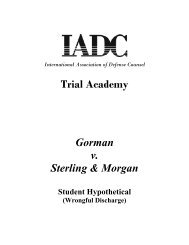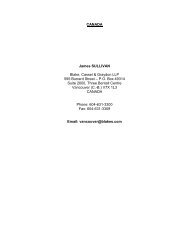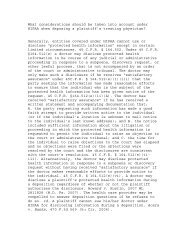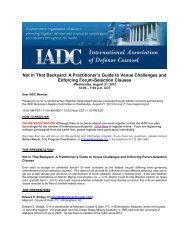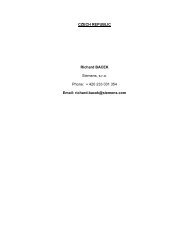Defense Counsel Journal - International Association of Defense ...
Defense Counsel Journal - International Association of Defense ...
Defense Counsel Journal - International Association of Defense ...
Create successful ePaper yourself
Turn your PDF publications into a flip-book with our unique Google optimized e-Paper software.
Predictability In Punitive Damages Page 463with the principle that “a jury must findcompensatory damages as a foundationbefore it may award punitive damages.” 68Next, the court noted that even wherepunitive damages may be appropriate, thedecision to award such damages is withinthe discretion <strong>of</strong> the trier <strong>of</strong> fact. 69Finally, the court concluded its overviewby stating that it is well settled underMaryland law that punitive damagescannot be decided in a vacuum, andcompensatory or actual damages must befound first in order to support an awardfor punitive damages. 70Recognizing that punitivedamages are meant to be a measure <strong>of</strong> thedefendant’s culpability, the courtnevertheless rejected the classrepresentatives’ argument that punitivedamages could be determined withoutregard to liability to any particular classmember. 71 The court then reiterated thatthere is “clearly established” law inMaryland prohibiting a punitive damageaward without regard to an actualcompensatory award. 72 Ultimately,although the court acknowledged the use<strong>of</strong> punitive damage multipliers in otherjurisdictions, it concluded that the use <strong>of</strong>a multiplier in this context would notenable the jury to assess appropriatepunitive damages relative to actualdamages and would be contrary toMaryland law. 7368 Id.69 Id. at 246-247.70 Id. at 247.71 Id.72 Id.73 Id. at 246-249.IV. ConclusionUsing a multiplier in determiningpunitive damage awards provides amethod for courts to avoid overdeterrencethrough multiple punitiveawards, increase the predictability andeconomic efficiency <strong>of</strong> punitive awards,and improve the overall efficiency inmass tort and complex litigation cases.Despite these benefits, opponents arguethat the multiplier approach deprivesdefendants <strong>of</strong> an opportunity to presentall <strong>of</strong> their defenses, as it does not allowfor individual determinations <strong>of</strong> punitivedamages for individual plaintiffs. Many<strong>of</strong> the arguments against the use <strong>of</strong> apunitive damage multiplier arise in casesin which plaintiffs are seeking adetermination as to punitive damages foran entire class before trying issues <strong>of</strong>causation and compensatory damages.This negative view <strong>of</strong> multipliers is <strong>of</strong>tenlinked to bifurcated trial plans that areobjectionable on other grounds.Courts and scholars that haveaddressed the advantages anddisadvantages <strong>of</strong> the punitive damagemultiplier have done so primarily withinthe class action context. The question yetto be addressed is whether a punitivedamage multiplier has a place in theworld <strong>of</strong> complex litigation beyond classactions. Where mass tort actions are notcertified as a class, they are <strong>of</strong>tenconsolidated for purposes <strong>of</strong> discoveryand trial. A punitive damage multipliermay be useful in this context, particularlywhere multiple parties’ actions areconsolidated for trial and representativeplaintiffs’ claims are presented to a juryto allow for a punitive damagedetermination. Regardless, the punitive



